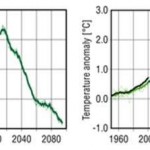
New York / Nairobi – By 2050, humanity could consume an estimated 140 billion tons of minerals, ores, fossil fuels and biomass per year – three times its current appetite – unless the economic growth rate is “decoupled” from the rate of natural resource consumption, warns a new report from the United Nations Environment Programme (UNEP).
Developed countries citizens consume an average of 16 tons of those four key resources per capita (ranging up to 40 or more tons per person in some developed countries). By comparison, the average person in India today consumes four tons per year.
With the growth of both population and prosperity, especially in developing countries, the prospect of much higher resource consumption levels is “far beyond what is likely sustainable” if realized at all given finite world resources, warns a new report titled “Decoupling: Natural Resource Use and Environmental Impacts from Economic Growth” by UNEP’s International Resource Panel.
Already the world is running out of cheap and high quality sources of some essential materials such as oil, copper and gold, the supplies of which, in turn, require ever-rising volumes of fossil fuels and freshwater to produce.
Improving the rate of resource productivity (“doing more with less”) faster than the economic growth rate is the notion behind “decoupling”, the panel says. That goal, however, demands an urgent rethink of the links between resource use and economic prosperity, buttressed by a massive investment in technological, financial and social innovation, to at least freeze per capita consumption in wealthy countries and help developing nations follow a more sustainable path.
The trend towards urbanization may help as well, experts note, since cities allow for economies of scale and more efficient service provision. Densely populated places consume fewer resources per capita than sparsely populated ones, thanks to economies in such areas as water delivery, housing, waste management and recycling, energy use and transportation, they say.
“Decoupling makes sense on all the economic, social and environmental dials,” says UN Under Secretary-General Achim Steiner, UNEP’s Executive Director.
“People believe environmental ‘bads’ are the price we must pay for economic ‘goods’. However, we cannot, and need not, continue to act as if this trade-off is inevitable,” he says. “Decoupling is part of a transition to a low carbon, resource efficient Green Economy needed in order to stimulate growth, generate decent kinds of employment and eradicate poverty in a way that keeps humanity’s footprint within planetary boundaries.”
“Next year’s Rio+20 meeting represents an opportunity to accelerate and scale-up these ‘green shoots’ of a Green Economy, which are emerging across the developed and developing world.”
The new report from UNEP’s International Resource Panel, the fourth in a series, was launched in New York at the annual meeting of the UN Commission on Sustainable Development, where sustainable consumption and production are key issues. And it precedes by a year the global UN Conference on Sustainable Development 2012 meeting (or “Rio+20” in Rio de Janeiro 4-6 June 2012) with its two central themes of a Green Economy in the context of sustainable development and poverty eradication, and achieving agreement on an international framework for sustainable development.
While the report doesn’t offer detailed policy and technology options – that’s for later reports – it says technologies that have helped humanity extract ever-greater quantities of natural resources need to be re-directed to more efficient ways of using them.
Global average annual per capita resource consumption in year 2000 was 8 to 10 tons, about double the rate of 1900. In 2000, the average rate in industrialized countries (home to one-fifth of world population) was roughly twice the global average and four or five times that of the poorest developing countries.
Global (and national) consumption rates per capita are calculated by dividing total world (and national) extractions of minerals, ores, fossil fuels and biomass by world (and national) population figures.
Rapidly expanding international trade, however, obscures responsibility for resource consumption and associated environmental impacts, the authors note.
Over the past century, pollution controls and other measures have reduced the environmental impacts of economic growth. And, thanks to innovations in manufacturing, product design and energy use – aided by the rising number of people living more efficient lifestyles in cities – the global economy has grown faster than resource consumption growth.
Still, those improvements have only been relative. In absolute terms – with population growth, continuing high levels of consumption in the industrialized countries, and increased demand for material goods, particularly in China, India, Brazil and other quickly-emerging economies – total resource use grew eight-fold, from 6 billion tons in 1900 to 49 billion tons in 2000. It is now estimated at up to 59 billion tons.
Decoupling is occurring but “at a rate that is insufficient to meet the needs of an equitable and sustainable society,” the report says. Between 1980 and 2002, the resources required per $ 1,000 (U.S.) of economic output fell from 2.1 to 1.6 tons.
The report details progress in four countries where government policy supports decoupling. Germany and Japan have both demonstrated the possibilities.
- Germany has established goals for energy and resource productivity – aiming to double both by 2020. There are also ambitious 2020 targets for meeting heating, electricity and other energy needs from renewable sources, and the target of a 30 per cent cut in carbon dioxide emissions by that same year.
- Japan is committed to becoming a “Sustainable Society” focused on low carbon, the reduction, reuse and recycling of materials, and harmony with nature. The flow of materials is carefully accounted. Japan’s measures “are probably the most advanced examples (of) increasing resource productivity and minimizing negative environmental impacts in practice,” the report states.
- South Africa‘s Constitution requires “ecologically sustainable development and use of natural resources.” Policies explicitly call for “resource and impact decoupling” and greenhouse-gas emission cuts of 30 to 40 per cent by 2050. Progress, though, is undermined by a growing reliance on exports of coal and other minerals. Its carbon intensity is the world’s highest and emissions per person are double the global average.
- China aims to build an “ecological civilization”, with resource and environmental concerns top priorities. It has created decoupling indicators and fixed mandatory targets, including a 20 per cent reduction of energy intensity and has run nationwide energy saving and pollution-reduction programs. A National Action Plan on Climate Change targets a 40 to 45 per cent reduction in carbon dioxide intensity by 2020.
China, in particular, is a global test case, “because it wants to continue its rapid economic growth but use resources more sustainably,” the report says. “The measures that China introduces to reconcile these objectives will be of crucial significance for every other developing country with similar policy intentions.”
The report emphasizes that cutting the rate of resource consumption and impacts is possible, in theory, if national economic improvement is defined in terms other than physical growth.
“It is time to recognize the limits to the natural resources available to support human development and economic growth,” the authors say.
Decoupling “will require significant changes in government policies, corporate behaviour, and consumption patterns by the public. … Innovation, even radical innovation, will be required.”














